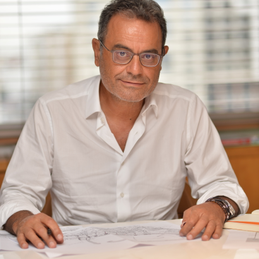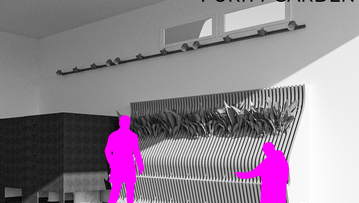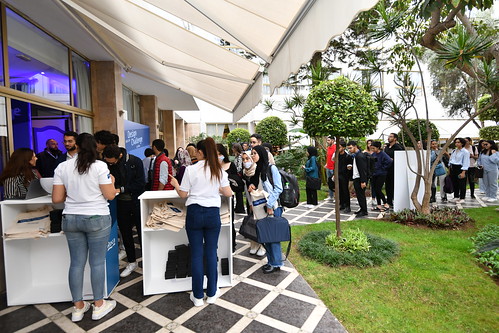MOROCCO
Date: May 14 · 2022
May 14 · 2022
Introduction
On May 14th, Rabat hosted the 1st edition of the Roca One Day Design Challenge in Morocco. The contest brought together more than 90 design and architecture students and young professionals from all over the country who faced the challenge of “Redesigning the traditional ablution unit.”
Among all the submitted projects, the three winners chosen by the jury members were:
1st prize. Purity garden, designed by Taha Toumi, student at École Nationale d'Architecture (Rabat).
The jury members decided to award the first prize to this project for being an innovative, refined and fresh proposal.
Its design, with well-defined areas for each use, allows users to perform ablution standing up. The jury also valued its integration proposal in public areas, as if it were a sculpture.
2nd prize. Wudu’U, designed by Lamyae Razi and Hamza Brahmi, students at École Nationale d’Architecture. Fès.
The jury members chose this project as the second winner, due to its careful and delicate design. The integration of the seat with the water area and the seating area, in an enveloping and well-defined piece, was valued. A proposal without superfluous ornaments, which maintains a style between the modern and the traditional.
3rd prize. Mr. Fibonacci. Designed by Ibtissam Zahir, student at the National Institute of fine arts. Tetouan.
The jury members awarded the third prize to this project for being a proposal of careful proportions and design.
The piece very well defines its different areas of use, from the delicate water area to functionality and access.
Awarded projects
Video
Gallery
Jury

RACHID BENBRAHIM EL ANDALOUSSI
Rachid Andaloussi graduated as laureate from the Ecole Spéciale d’Architecture (ESA) in Paris in 1984.
From the outset, the young architect claimed adherence to the heritage of avant-garde modern architectural movements from the 1920s to the 1960s, which to an exceptional degree shaped the city of Casablanca.
Jean Louis Cohen, historian of 20th century architecture and world authority on the subject, would not be wrong in noting in Rachid Andaloussi's projects to come the influences of some of the architects who have left the greatest mark on the Casablanca landscape: Marius Boyer, Elie Azagury, and Zevaco.
Since he opened his architectural office in 1990, RACHID BENBRAHIM EL ANDALOUSSI has worked ceaselessly. His now considerable opus makes him indisputably one of the most prolific and gifted Moroccan architects of his generation. Especially since, despite the diversity of his projects, his stamp can still be distinguished by observers from the work of other architects: the colour white, horizontal lines, play of light and shadow, pared-back form, devoid of clutter, integration into the environment, fluidity of circulation, the concern for functionality – all culminating in an aesthetic that rigorously rejects any pretentiousness or facile flattery.
"There's no such thing as a small project", according to Rachid Andaloussi. In his many plans for art galleries, the construction of imposing corporate headquarters, the design of rental apartment blocks or mansions, the same impulse to "draw on the lessons of the past in order to better look to the future" guides the pencil of the Architect.

Mohamed Fikri Benabdallah
Mohamed Fikri Benabdallah graduated in 1980 from the Paris Ecole Nationale Supérieure des Beaux-Arts – UP1.
Fikri Benabdallah joined the architecture department of the Ministry of Urban Planning in Rabat in 1981, where for ten years he was in charge of a major urban research programme.
He was elected Secretary General of the Moroccan National Association of Architects and Town Planners in 1985 and in 1992 joined the Superior Council of the Order of Architects.
He was also a founding member of the Steering Committee of the Forum des Architectes. Between 1985 and 2002 he taught at the Ecole Nationale d’Architecture in Rabat where he trained many years' intakes of architects.
At that time, he also proposed the shortlist for the Aga Khan prize for architecture for several years. In 2001, he founded the Groupement Confluences with the architects Rachid Andaloussi, Taoufiq El Oufir, Abdelouahed Mountassir and Jacques Barbier, authors of the Parti d'Aménagement Global de la Vallée du Bouregreg (Comprehensive Bouregreg Valley Development Scheme).
In 2014, he founded and chaired the Rabat Salé Mémoire association, for the preservation of the heritage of Rabat Salé. In 2010 Mr. Benabdallah was shortlisted for the Aga Khan Prize for the restoration of the Al Qaraouiyine Mosque in Fez.
His most important projects include the Nejjarine Museum of Wood Arts and Crafts in Fez; the Maâmora Nuclear Studies Centre; the air terminals of Fez, Oujda, Ouarzazate and Al Hoceima; the Benslimane military base; the El Jadida Provincial Hospital; the Court of First Instance of Meknes; and the new bus station in Rabat.
In association with Rachid Andaloussi: the University Hospital of Agadir; and in Rabat, the headquarters of the Kingdom of Morocco Ombudsman Institute, and the central headquarters of the Parti du Progrés et du Socialisme.

Chakib Jaidi
He was born in Rabat (Morocco) on 20 December 1954, into a family from Salé. In 1974, he left to study in France, where he graduated from the UPA in Toulouse.
There ensued a long journey of initiation around the world during which he discovered South America, and notably the West Indies in his research on bamboo as building material in a tropical environment.
From 1983 to 1985, he worked as a partner in a firm of architects in the West Indies. On his return to Morocco, he founded his own office, ChakibJaidi Architecture, in 1986. His work covers numerous sectors, from social housing to private homes, from health clinics to hotels, and includes interior décor and furniture design.
The projects he has built in Morocco draw their strength from the mastery of space and light, manipulating the physical and poetic attributes of the material.

Jordi Pérez
A graduate in Industrial Design from Elisava Barcelona School of Design and Engineering. He has worked in Spain and Italy in product development for some of the leading international companies in the design industry.
Since 2002, he has formed part of the Roca Design Center. He has worked as a lecturer at Elisava and the Centro Ricerche Domus Academy (Milan).
He has won several design awards and accolades for his work.













